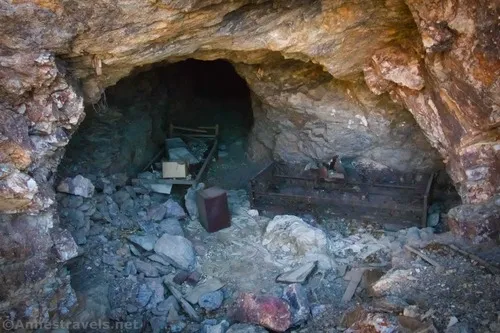
Big Bell Extension – Death Valley National Park
A steep but very scenic trail up to one of the last purchases of the Keane Wonder Mine.
| Total Distance: 6.0 miles out & back | Elevation Gain: 2,199ft. (1,184ft. to 2,995ft.) |
| Difficulty: Strenuous | 5+ Mile Difficulty: Strenuous |
| View Rating: 5.0 out of 5.0 stars | Author’s Rating: 4.0 out of 5.0 stars |
| Visitor Rating: (Click to rate) [Total: 0 Average: 0] | Visitor Difficulty Rating: (Click to rate) [Total: 0 Average: 0] |
| Pets: No | Horses: No |
| Best Seasons: November-April | Special Permits: None |
| Water Availability: No potable water; no water above John Cyty’s Mill. | Overnight Options: Above John Cyty’s Mill; be sure to camp at least 1 mile (as the crow flies) from the Keane Wonder Mine Trail |
| Trailhead Amenities: None | Crowd Factor: Solitude |
| Trailhead Access: 1.2 | |
| Uses: | Trail Surface:  |
| Features: | Hazards: |
Mile-by-Mile: Big Bell Extension Route
0.0 Unmarked Keane Wonder Spring Trailhead (1,317ft.). This is not the Keane Wonder Trailhead; the unmarked, almost unidentifiable trail is located about halfway down the west side of the Keane Wonder Parking Lot. Head west down by the old water tank and locate one of the two trails (there are two trails for much of the hike to John Cyty’s Mill) and follow it generally northwest along the old pipeline to John Cyty’s Cabin & Mill. (36.667797°, -116.910710°)
1.2 John Cyty’s Cabin & Mill (1,260ft.). Climb up the vague trail behind the old stamp mill. It fairly quickly becomes more defined and lazily ascends the hillside heading north before beginning a steep, rocky, but stable, trek up into the mountains about mile 1.3. Views as you climb are stunning of Death Valley, the Badwater Salt Flats to the south, and Corkscrew Peak to the north. To the west, after you’ve climbed high enough, Mount Whitney is visible on a clear day. This means you can see the lowest point in North America (Badwater) and the highest peak in the contiguous US (Mt. Whitney) at the same time! Views are especially good just below the saddle. (36.676338°, -116.926834°)
2.6 Saddle (2,728ft.). Views stretch in nearly all directions and are especially good of Corkscrew Peak to the west and up the nearby canyon to the east. Turn right to begin walking on the very narrow but firm track along the canyon edge. This is not a trail for those who dislike heights, as there is a very steep dropoff right next to the trail. Many boreholes have been made into the side of the hill to look for possible ore veins. This area is known as the Big Bell Extension, as it was used as an attempt by John Cyty to expand the Big Bell Mine, which is further up the trail. (36.6893000°, -116.9180333°)
2.9 Big Bell Extension Bore Hole (2,890ft.). Two beds and other debris litter the entrance to the mine. A short distance further up the trail are the remains of an old cabin. The trail after the cabin becomes much more rugged and narrow, but it is still stable. (36.6902333°, -116.9130667°)
3.0 Trail Junction (2,994ft.). The left fork takes you to some old mines, while the right fork takes you up to the Big Bell Mine Ruins. However, to the best of my knowledge, private property begins near here, so it’s best not to go much beyond this point. (36.691680°, -116.911111°)
History & More
John Cyty extracted ore from the mines near the Big Bell Extension. However, the mines did not prove profitable enough to continue work, despite the fact that Mr. Cyty spent years prospecting in the area.
The Big Bell Extension was purchased by the Keane Wonder Mine Company as the original mine began to run dry. While the Big Bell Mine did produce gold ore, it was never as rich or profitable as the Keane Wonder Mine.
Download Trail Map
Coming soon!
Driving Directions
From Furnace Creek, take CA-190 north 10.6 miles to the junction for the Beatty Cutoff. Turn right toward Beatty. After 5.7 miles of driving north, turn right on the gravel road to the Keane Wonder Mine Trailhead, 2.8 miles later.
It is extremely dangerous to enter a mine due to unstable shafts, gasses, and more. Do not enter mines, even if they are apparently open!
Walking on, climbing, entering, ascending, descending, or traversing any mine, structure, feature, or ruin is prohibited.
Toxic chemicals or ore may be present around mine sites. Enter at your own risk.
Possessing, destroying, injuring, defacing, removing, digging, or disturbing any mine, structure, feature, or ruin is also prohibited.
Leave No Trace Principles are enforced
Drones and model aircrafts are prohibited
Camping is permitted only in designated sites or in areas open to dispersed backcountry camping
All park rules and regulations
12 Month Pass: $55/Death Valley Annual Pass (valid at Death Valley National Park). $80/America the Beautiful Annual Pass (valid at all national park and federal fee areas). $20/Annual Senior Pass (62 years or older US citizens; valid at all national park and federal fee areas). Free/4th Grade Pass (Valid Sept. 1-August 31 of the child’s 4th Grade school year). Free/Military Pass (valid for all active military personel and their dependents with a CAC Card or DD Form 1173).
Lifetime Pass: $80/Lifetime Senior Pass (62 years or older US citizens; valid at all national park and federal fee areas). Free/Access Pass (available to all US citizens with perminent disabilities). Free/Access for Veterans and Gold Star Families Pass (valid for all military and veterans with a CAC card, Veteran HJealth Identification Card, Veteran ID Card, or veteran’s designation on state-issued drivers license or identification card.)




















